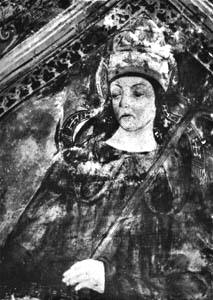 St. Agatho ranks with St. Leo the Great and St. Hormisdas for his
outstanding contribution to orthodoxy in the East. Agatho was a Sicilian,
probably from Palermo. It is possible that he is the Agatho referred to by
St. Gregory the Great in a letter to the abbot of St. Hermes in Palermo.
The abbot, wrote Gregory, could receive Agatho into his monastery if
Agatho's wife was willing to enter a convent. There are reasons to believe
that Pope Agatho is this monk, but on the other hand it would make him a
very old man indeed. Monk or not, Agatho was a man of amiable disposition
who got along well with people. Probably he was efficient in business
matters too, for contrary to custom, he kept the treasurer's office in his
own hand after becoming pope.
St. Agatho ranks with St. Leo the Great and St. Hormisdas for his
outstanding contribution to orthodoxy in the East. Agatho was a Sicilian,
probably from Palermo. It is possible that he is the Agatho referred to by
St. Gregory the Great in a letter to the abbot of St. Hermes in Palermo.
The abbot, wrote Gregory, could receive Agatho into his monastery if
Agatho's wife was willing to enter a convent. There are reasons to believe
that Pope Agatho is this monk, but on the other hand it would make him a
very old man indeed. Monk or not, Agatho was a man of amiable disposition
who got along well with people. Probably he was efficient in business
matters too, for contrary to custom, he kept the treasurer's office in his
own hand after becoming pope.
The great event of this pontificate was the Sixth General Council, the
Third of Constantinople which extinguished the Monothelite heresy and
reunited Constantinople to Rome. It started when Emperor Constantine IV,
the Bearded, having pacified the empire politically, desired to pacify it
religiously. This capable ruler had defeated the Saracens and held back the
Avars. Now he deplored the schism which separated the East from Rome.
He
wrote to Pope Donus suggesting a conference on the matter. Donus was
dead
by the time the letter arrived, but Agatho was quick to seize the olive
branch proffered by the Emperor. He ordered councils held throughout the
West so that legates could present the universal tradition of the Western
Church. Then he sent a large delegation to meet the Easterners at
Constantinople.
The projected conference developed into a general council. The legates,
patriarchs, and fathers gathered in the domed hall of the imperial palace
on November 7, 680. The Monothelites or One Will heretics presented their
case. Then the letter of Pope Agatho was read which explained the
traditional belief of the Church that in Christ there are two wills, divine
and human. The council agreed that Peter spoke through Agatho. Patriarch
George of Constantinople accepted Agatho's letter, as did most of the
bishops present. The council proclaimed the existence of the two wills in
Christ and condemned the old Monothelites Sergius and Cyrus. Pope
Honorius
was included in the condemnation. When the council ended in September of
681 the decrees were sent to the Pope, but Agatho had died in January.
The
Sixth General Council not only ended the Monothelite heresy but it healed
the schism between Constantinople and Rome.
Pope Agatho also had to judge an appeal made from England by Wilfrid,
bishop of York. Wilfrid arrived in Rome in 679 to protest against the
action of Theodore, archbishop of Canterbury. Theodore had carved up
Wilfrid's diocese, appointing three bishops to govern the new sees. Wilfrid
appealed to the Pope against this rather arbitrary proceeding. Pope Agatho
held a council to discuss the matter, and the wise decision was that
Wilfrid's diocese should indeed be divided, but that Wilfrid himself should
name the bishops.
Agatho is venerated as a saint by both Latins and Greeks.
Excerpted from "Popes
Through the Ages" by Joseph Brusher, S.J.

